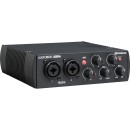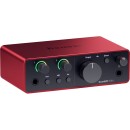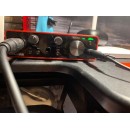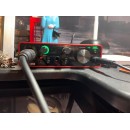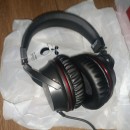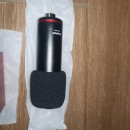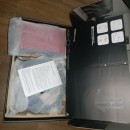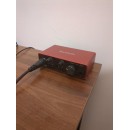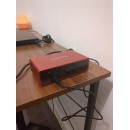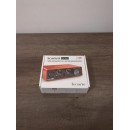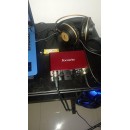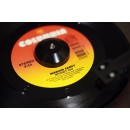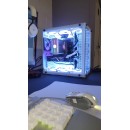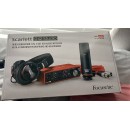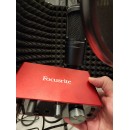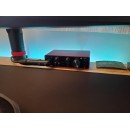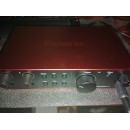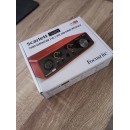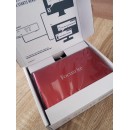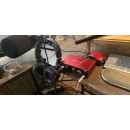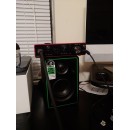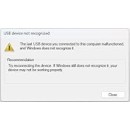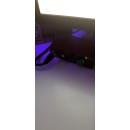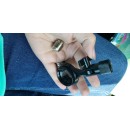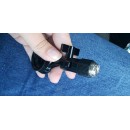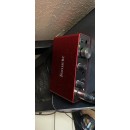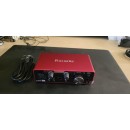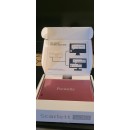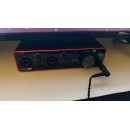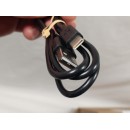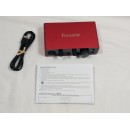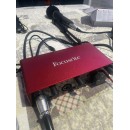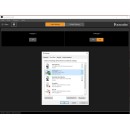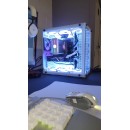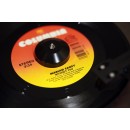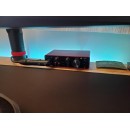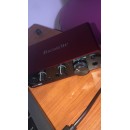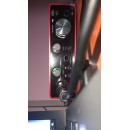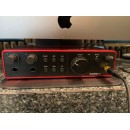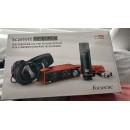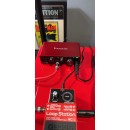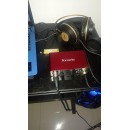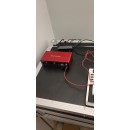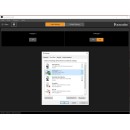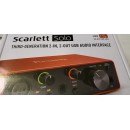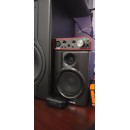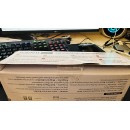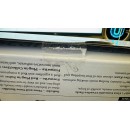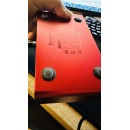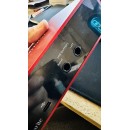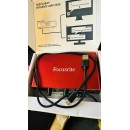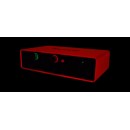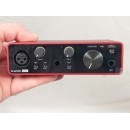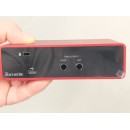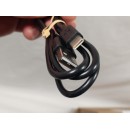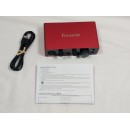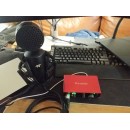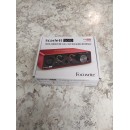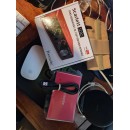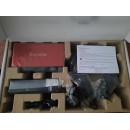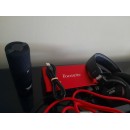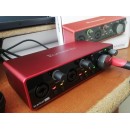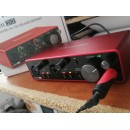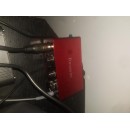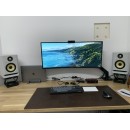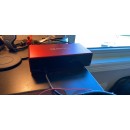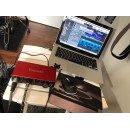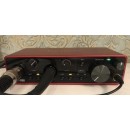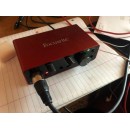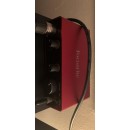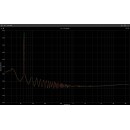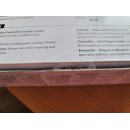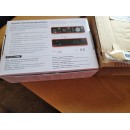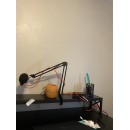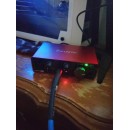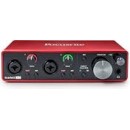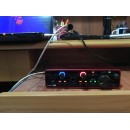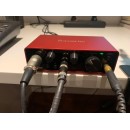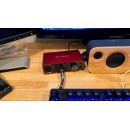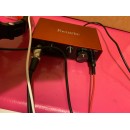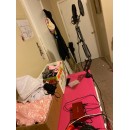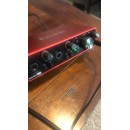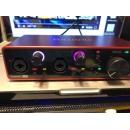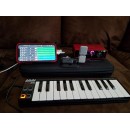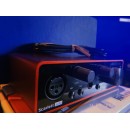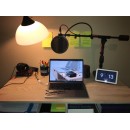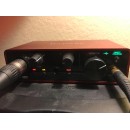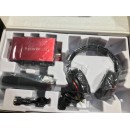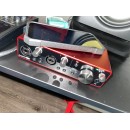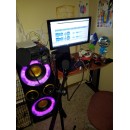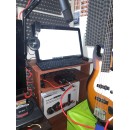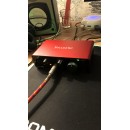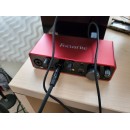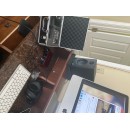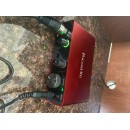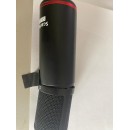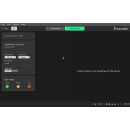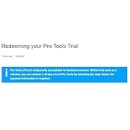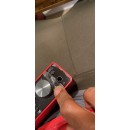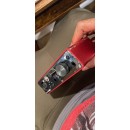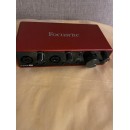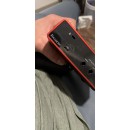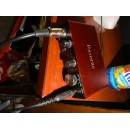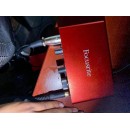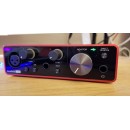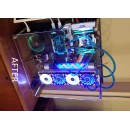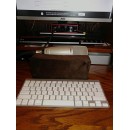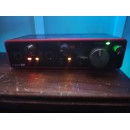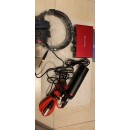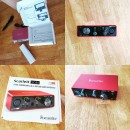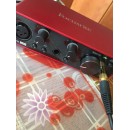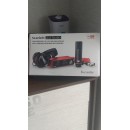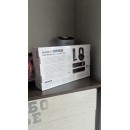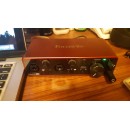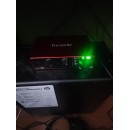PreSonus AudioBox USB 96 vs Focusrite Scarlett Solo: A Detailed Comparison
The Focusrite Scarlett Solo (4th Generation) is known for its premium build quality and excellent sound fidelity. It features a single mic preamp that delivers a clean and transparent sound, ideal for vocals and acoustic instruments. The interface supports USB-C connectivity, which is becoming the standard for modern devices, offering faster data transfer rates and improved power handling. The Scarlett Solo includes a high-headroom instrument input for guitars and basses and offers 24-bit/192kHz conversion, ensuring top-notch audio resolution. Additionally, the Focusrite Scarlett Solo comes with a suite of software, including Ableton Live Lite and the Focusrite Red Plug-in Suite, providing users with valuable tools for recording and mixing.
On the other hand, the PreSonus AudioBox USB 96 25th-Anniversary Edition is a versatile and more robust option, featuring two combo inputs that accommodate both XLR and 1/4" connections, making it suitable for recording multiple sources simultaneously. It supports USB-B connectivity, which is widely compatible with both older and newer computers. The AudioBox USB 96 offers MIDI I/O, a feature not present in the Scarlett Solo, allowing users to connect MIDI keyboards and controllers. This interface also supports 24-bit/96kHz audio resolution, which is slightly lower than the Scarlett Solo but still provides professional-quality sound. The AudioBox USB 96 comes with Studio One Artist software, a powerful DAW that includes a variety of effects and virtual instruments, making it a comprehensive package for music production.
In summary, the Focusrite Scarlett Solo (4th Generation) is ideal for solo artists and podcasters looking for pristine audio quality and modern connectivity options. Its single preamp and high-resolution conversion make it a great choice for high-fidelity recordings. Conversely, the PreSonus AudioBox USB 96 25th-Anniversary Edition offers more flexibility with its dual inputs and MIDI support, making it better suited for musicians who need to record multiple sources or integrate MIDI devices. Both interfaces come with valuable software packages, but the choice ultimately depends on the specific needs and workflow preferences of the user.
Specifications, Advantages, and Disadvantages
| User Rating Based on Analysis of Reviews | |
|---|---|
|
Show More |
| Pros: | |
|---|---|
|
|
| Cons: | |
|---|---|
|
|
| Find Best Price | Find Best Price |
| Key Specs | |
|---|---|
| Channels of I/O | |
| Analog: 2 Inputs / 2 Outputs at 96 kHz |
Analog: 2 Inputs / 2 Outputs at 192 kHz |
| Maximum Sampling Rate | |
| 96 kHz / 24-Bit | 192 kHz / 24-Bit |
| Number of Microphone Inputs | |
| 2 Preamps | 1 |
| Analog Audio I/O | |
| 2x Combo XLR-1/4" TS Balanced/Unbalanced Mic/Hi-Z Input (Pin 2 Hot) 2x 1/4" TRS Balanced Line/Monitor Output 1x 1/4" TRS Unbalanced Headphone Output |
1x XLR 3-Pin Balanced Mic Input 1x 1/4" TS Unbalanced Line/Hi-Z Input (Front Panel) 2x 1/4" TRS Balanced Monitor Output 1x 1/4" TRS Headphone Output (Front Panel) |
| Host Connection | |
| 1x USB-B | 1x USB-C |
| OS Compatibility | |
| macOS 10.11 or Later (64-Bit Only) Windows 7 or Later (32-/64-Bit) |
macOS Windows |
| Power Requirements | |
| USB Bus Power | USB Bus Power, USB Power Adapter (Not Included) |
The Focusrite Scarlett Solo offers 2 analog input channels and 2 output channels with a maximum sampling rate of 192 kHz and 24-bit resolution. It includes 1 microphone input and features 1 XLR 3-pin balanced mic input, 1/4" TS unbalanced line/Hi-Z input on the front panel, and 2x 1/4" TRS balanced monitor outputs. Additionally, it has a 1/4" TRS headphone output on the front panel. The device connects to the host via a USB-C port and is compatible with both macOS and Windows operating systems. It is powered via USB bus power, with an optional USB power adapter available but not included.
In contrast, the PreSonus AudioBox USB 96 25th-Anniversary Interface also offers 2 analog input channels and 2 output channels but with a maximum sampling rate of 96 kHz and 24-bit resolution. It features 2 microphone preamps and includes 2 combo XLR-1/4" TS balanced/unbalanced mic/Hi-Z inputs (Pin 2 Hot) and 2x 1/4" TRS balanced line/monitor outputs. The device also includes a 1/4" TRS unbalanced headphone output. The host connection is via a USB-B port, and it is compatible with macOS 10.11 or later (64-bit only) and Windows 7 or later (32-/64-bit). Power is supplied through USB bus power.
In summary, the Focusrite Scarlett Solo offers a higher maximum sampling rate of 192 kHz compared to the 96 kHz of the PreSonus AudioBox USB 96. The Scarlett Solo has a single mic input, whereas the AudioBox USB 96 provides two, which may be beneficial for users requiring multiple microphone inputs. Host connectivity differs as well, with the Scarlett Solo using USB-C and the AudioBox USB 96 utilizing USB-B. Both devices are cross-compatible with macOS and Windows, and both are powered via USB bus power.
| General | |
|---|---|
| Channels of I/O | |
| Analog: 2 Inputs / 2 Outputs at 96 kHz |
Analog: 2 Inputs / 2 Outputs at 192 kHz |
| Maximum Sampling Rate | |
| 96 kHz / 24-Bit | 192 kHz / 24-Bit |
| Number of Microphone Inputs | |
| 2 Preamps | 1 |
| Input Level Adjustment | |
| 2x Knob | 2x Knob |
| Expansion Slots | |
The Focusrite Scarlett Solo offers analog I/O channels of 2 inputs and 2 outputs, operating at a maximum sampling rate of 192 kHz at 24-bit resolution. This makes it ideal for users who need high-definition audio quality. It comes equipped with a single microphone input, making it a great choice for solo musicians or podcasters who typically work with one microphone. The device does not feature built-in DSP or a built-in microphone but does include two knobs for input level adjustment, allowing for precise control over audio levels. While it lacks expansion slots, its clean and efficient design, coupled with its USB-C connectivity, ensures fast data transfer and minimal latency.
On the other hand, the PreSonus AudioBox USB 96 also provides 2 inputs and 2 outputs but at a maximum sampling rate of 96 kHz at 24-bit resolution. While the sampling rate is lower compared to the Scarlett Solo, it is still sufficient for most professional audio applications. This interface boasts two microphone preamps, which makes it more versatile for users who need to record multiple vocalists or instruments simultaneously. Like the Scarlett Solo, it also includes two knobs for input level adjustment and does not have built-in DSP or expansion slots. The PreSonus AudioBox connects via USB-B, which is widely compatible but may offer slightly slower data transfer rates compared to USB-C.
In summary, the Focusrite Scarlett Solo excels in high-definition audio recording with its 192 kHz sampling rate and is ideal for solo work with its single microphone input. The PreSonus AudioBox USB 96, while offering a lower sampling rate, provides greater versatility with its two microphone preamps, making it suitable for recording multiple sources simultaneously. Both interfaces are equipped with essential features for input level adjustment and lack built-in DSP and expansion slots, ensuring a straightforward and user-friendly experience.
| Signal Processing | |
|---|---|
| Gain/Trim Range | |
| Mic Inputs: 0 dB to +60 dB Hi-Z Inputs: -10 dB to +30 dB Monitor Outputs: -80 dB to +10 dB |
Mic/Line Inputs: Up to +69 dB Hi-Z Inputs: 62 dB |
In contrast, the PreSonus AudioBox USB 96 25th-Anniversary USB-B Audio/MIDI Interface offers a gain/trim range for mic inputs from 0 dB to +60 dB and Hi-Z inputs from -10 dB to +30 dB. Additionally, its monitor outputs have a gain range from -80 dB to +10 dB. The interface lacks a pad, high-pass filter, and solo/mute functions, which might limit some users' flexibility in managing their audio signals directly from the interface. The USB-B connectivity, while slightly older, remains reliable and widely compatible with many systems.
In summary, the Focusrite Scarlett Solo provides a higher gain range on both mic and Hi-Z inputs, along with modern USB-C connectivity, making it potentially more suitable for users requiring greater input headroom and faster data transfer. The PreSonus AudioBox USB 96, while offering a slightly lower gain range and additional output gain control, lacks certain features such as a pad, high-pass filter, and solo/mute options, which could be a consideration for users needing these functionalities.
| Connectivity | |
|---|---|
| Analog Audio I/O | |
| 2x Combo XLR-1/4" TS Balanced/Unbalanced Mic/Hi-Z Input (Pin 2 Hot) 2x 1/4" TRS Balanced Line/Monitor Output 1x 1/4" TRS Unbalanced Headphone Output |
1x XLR 3-Pin Balanced Mic Input 1x 1/4" TS Unbalanced Line/Hi-Z Input (Front Panel) 2x 1/4" TRS Balanced Monitor Output 1x 1/4" TRS Headphone Output (Front Panel) |
| Phantom Power | |
| 48 V, Selectable On/Off (Applied to All Inputs) | 48 V, Selectable On/Off |
| Digital Audio I/O | |
| Host Connection | |
| 1x USB-B | 1x USB-C |
| Host Connection Protocol | |
| USB 2.0 | USB 2.0 |
| USB (Non-Host) | |
| Sync I/O | |
| Network I/O | |
| MIDI I/O | |
| 1x DIN 5-Pin Input 1x DIN 5-Pin Output |
|
The Focusrite Scarlett Solo 4th Generation offers a streamlined analog audio I/O setup with a single XLR 3-pin balanced mic input and a single 1/4" TS unbalanced line/Hi-Z input on the front panel. For outputs, it features two 1/4" TRS balanced monitor outputs as well as a 1/4" TRS headphone output on the front panel. This interface supports 48V phantom power, which is selectable on or off, catering to condenser microphones. Connectivity to the host is achieved via a USB-C connection, utilizing USB 2.0 protocol. Notably, the Scarlett Solo does not have digital audio I/O, sync I/O, network I/O, or MIDI I/O capabilities.
In contrast, the PreSonus AudioBox USB 96 25th-Anniversary edition has a more versatile analog audio I/O configuration. It includes two combo XLR-1/4" TS balanced/unbalanced mic/Hi-Z inputs, providing more flexibility for different types of input sources. On the output side, it offers two 1/4" TRS balanced line/monitor outputs and a single 1/4" TRS unbalanced headphone output. Similar to the Scarlett Solo, it supports 48V phantom power, which is also selectable on or off but applied to all inputs simultaneously. The host connection is facilitated via a USB-B port, also using USB 2.0 protocol.
One significant advantage of the AudioBox USB 96 is the inclusion of MIDI I/O, featuring one DIN 5-pin input and one DIN 5-pin output. This makes it a more versatile option for users who require MIDI connectivity for integrating MIDI controllers and other MIDI-compatible devices.
In summary, the Focusrite Scarlett Solo 4th Generation is a more streamlined, straightforward interface primarily focused on high-quality analog audio recording with minimal inputs and outputs, making it ideal for solo musicians or podcasters. On the other hand, the PreSonus AudioBox USB 96 offers more input versatility and the added benefit of MIDI I/O, catering to users who need greater flexibility and MIDI integration in their recording setup.
| Performance | |
|---|---|
| Frequency Response | |
| Mic Inputs: 20 Hz to 20 kHz ±3 dB Headphone Outputs: 20 Hz to 30 kHz ±1 dB |
XLR Mic Inputs: 20 Hz to 20 kHz ±0.06 dB 1/4" Line Inputs: 20 Hz to 20 kHz 0.05 dB 1/4" Hi-Z Inputs: 20 Hz to 20 kHz 0.15 dB |
| Maximum Input Level | |
| Mic Inputs: -3 dBu (Unity Gain, 1 kHz) |
XLR Mic: 9.5 dBu 1/4" Line: 22 dBu 1/4" Hi-Z: 12 dBu |
| Headphone Output Power | |
| 60 mW per Channel into 60 Ohms (Max) |
1/4": 32 mW into 33 Ohms 22 mW into 300 Ohms |
| Impedance | |
| Mic Inputs: 1.2 Kilohms (Balanced) Hi-Z Inputs: 0.5 Megohms (Unbalanced) Outputs: 51 Ohms (Balanced) |
XLR Mic Inputs: 3 Kilohms 1/4" Line Inputs: 60 Kilohms 1/4" Hi-Z Inputs: 1 Megohms 1/4" Line Outputs: 200 Ohms 1/4" Headphone Outputs: < 50 Ohm |
| Dynamic Range | |
| AD/DA Converters: 105 dBA (48 kHz Sample Rate) |
XLR Mic Inputs: 113 dBA 1/4" Line Inputs: 113 dBA 1/4" Hi-Z Inputs: 112 dBA 1/4" Line Outputs: 120 dB 1/4" Headphone: 112 dB (at 33 Ohms) 115 dB (at 300 Ohms) Digital A/D Converters: 120 dB Digital D/A Converters: 130 dBA |
| THD+N | |
| Mic Inputs: < 0.008% (Unweighted, 1 kHz, Unity Gain) |
XLR Mic Inputs: -100 dB (at Minimum Gain) 1/4" Line Inputs: -100 dB (at 8 dB Gain) 1/4" Hi-Z Inputs: -80 dB (at Minimum Gain) 1/4" Line Outputs: -100 dB (at Minimum Gain) 1/4" Headphone Outputs: -97 dB (at 33 Ohms) -102 dB (at 300 Ohms) Digital A/D Converters: -110 dB Digital D/A Converters: -115 dB |
The Focusrite Scarlett Solo USB-C Audio Interface (4th Generation) boasts impressive specifications, including a frequency response of 20 Hz to 20 kHz with varying deviations depending on the input type: ±0.06 dB for XLR mic inputs, 0.05 dB for 1/4" line inputs, and 0.15 dB for 1/4" Hi-Z inputs. It also supports a maximum input level of 9.5 dBu for XLR mic, 22 dBu for 1/4" line, and 12 dBu for 1/4" Hi-Z inputs. The maximum output level for 1/4" line outputs is +16 dBu. The headphone output power is 32 mW into 33 Ohms and 22 mW into 300 Ohms. The interface has various impedance ratings, including 3 Kilohms for XLR mic inputs and 1 Megohm for 1/4" Hi-Z inputs. It offers a dynamic range of 113 dBA for both XLR mic and 1/4" line inputs, with the output dynamic range reaching up to 130 dBA for digital D/A converters. The THD+N values are notable as well, with -100 dB for XLR mic inputs at minimum gain and -115 dB for digital D/A converters. The equivalent input noise (EIN) for XLR mic inputs is -127 dBu A-weighted, enhancing its low-noise performance.
On the other hand, the PreSonus AudioBox USB 96 25th-Anniversary USB-B Audio/MIDI Interface offers a frequency response of 20 Hz to 20 kHz ±3 dB for mic inputs and 20 Hz to 30 kHz ±1 dB for headphone outputs. Its maximum input level for mic inputs is -3 dBu at unity gain and 1 kHz. The headphone output power is higher than that of the Scarlett Solo, providing 60 mW per channel into 60 Ohms. Impedance ratings for the AudioBox include 1.2 Kilohms for balanced mic inputs and 0.5 Megohms for unbalanced Hi-Z inputs. The dynamic range for AD/DA converters is 105 dBA at a 48 kHz sample rate. The signal-to-noise ratio (SNR) is 95 dB at +4 dBu, 1 kHz, and unity gain. For THD+N, the mic inputs have a value of less than 0.008% unweighted at 1 kHz and unity gain. Additionally, it features a common-mode rejection ratio (CMRR) greater than 45 dB at 1 kHz and 55 dB gain.
In conclusion, the Focusrite Scarlett Solo USB-C Audio Interface (4th Generation) excels in dynamic range, low noise, and harmonic distortion characteristics, making it suitable for high-fidelity recording environments. Conversely, the PreSonus AudioBox USB 96 offers a wider frequency response for headphone outputs and higher headphone output power, which could be advantageous for users needing robust monitoring capabilities. Each interface has unique strengths tailored to different audio production needs.
| Digital Audio | |
|---|---|
| Sample Rates | |
| 44.1 / 48 / 88.2 / 96 kHz | 44.1 / 48 / 88.2 / 96 / 176.4 / 192 kHz |
| Bit Depths | |
| 24-Bit | 24-Bit |
| Sync Sources | |
| Internal | Internal |
The Focusrite Scarlett Solo 4th Generation supports a wider range of sample rates, including 44.1, 48, 88.2, 96, 176.4, and 192 kHz, giving users more flexibility in achieving high-quality audio recordings. In comparison, the PreSonus AudioBox USB 96 supports sample rates of 44.1, 48, 88.2, and 96 kHz, which may suffice for many users but does not reach the higher sample rates that the Scarlett Solo offers. Both interfaces support a bit depth of 24-bit, ensuring high-resolution audio capture.
In terms of sync sources, both the Focusrite Scarlett Solo and the PreSonus AudioBox USB 96 rely on internal synchronization, which is standard for most audio interfaces in this category. However, the PreSonus AudioBox USB 96 specifies a dBFS reference level of +4 dBu = 0 dBFS, a detail that is not explicitly mentioned for the Scarlett Solo. This specification is crucial for maintaining consistent audio levels and ensuring compatibility with other professional audio equipment.
One notable difference is the sample rate conversion feature, which is absent in the PreSonus AudioBox USB 96. This means that the interface does not support converting sample rates during playback or recording, potentially limiting its versatility in certain professional audio environments. The Focusrite Scarlett Solo does not specify this feature, which may suggest it either supports it inherently or does not emphasize it as a key feature.
Overall, the Focusrite Scarlett Solo 4th Generation offers broader sample rate support, making it a more versatile choice for users who require higher sample rates for their projects. The PreSonus AudioBox USB 96, while limited to lower sample rates, provides essential features like a specific dBFS reference level, ensuring reliable audio performance in various recording scenarios.
| Audio Storage & Playback |
|---|
| Compatibility | |
|---|---|
| OS Compatibility | |
| macOS 10.11 or Later (64-Bit Only) Windows 7 or Later (32-/64-Bit) |
macOS Windows |
In terms of OS compatibility, both devices support macOS and Windows. The Focusrite Scarlett Solo is compatible with macOS and Windows operating systems generally, while the PreSonus AudioBox is specifically compatible with macOS 10.11 or later (64-bit only) and Windows 7 or later (both 32- and 64-bit versions).
When it comes to mobile app compatibility, the Focusrite Scarlett Solo has an edge as it is compatible with iPadOS, allowing users to integrate it with iPads for mobile recording setups. In contrast, the PreSonus AudioBox does not offer any mobile device compatibility, focusing solely on computer-based recording environments.
Regarding hardware requirements, the PreSonus AudioBox has more specific requirements: it needs an Intel Core Duo processor for Mac and an Intel Core 2 processor for PC. It also specifies RAM requirements of 2 GB minimum for Mac (4 GB recommended) and 4 GB minimum for PC (8 GB recommended), along with a 20 GB storage requirement and a minimum display resolution of 1024 x 768. Additionally, it requires an available USB 2.0 port, which is provided via an included USB cable, and an internet connection for registration and software/driver downloads.
The Focusrite Scarlett Solo, on the other hand, does not list such detailed hardware requirements, suggesting a potentially less demanding setup process. This can be an advantage for users seeking a more straightforward and less resource-intensive installation.
In summary, the Focusrite Scarlett Solo USB-C Audio Interface (4th Generation) excels in mobile app compatibility and potentially simpler hardware requirements, making it a versatile choice for both desktop and mobile recording setups. The PreSonus AudioBox USB 96 25th-Anniversary USB-B Audio/MIDI Interface, with its detailed hardware requirements and lack of mobile compatibility, is more tailored to users with specific desktop recording needs who can meet its more stringent system specifications.
| Power | |
|---|---|
| Power Requirements | |
| USB Bus Power | USB Bus Power, USB Power Adapter (Not Included) |
The Focusrite Scarlett Solo (4th Generation) offers flexibility in its power options. It can be powered through USB bus power or via a USB power adapter, although the adapter is not included with the interface. Additionally, it supports an AC/DC power adapter with a specification of 5 VDC at 900 mA. The total power consumption of the Scarlett Solo is 4.5 watts, which indicates its energy consumption requirements when in operation.
On the other hand, the PreSonus AudioBox USB 96 25th-Anniversary model is designed to be powered solely through USB bus power. This means it does not offer the option to use an external power adapter, relying entirely on the power supplied by the connected USB port.
In summary, the Focusrite Scarlett Solo (4th Generation) provides more versatility with multiple power options, including USB bus power, a USB power adapter, and an AC/DC adapter, with a specific power consumption of 4.5 W. The PreSonus AudioBox USB 96, while simpler in its approach, depends exclusively on USB bus power without requiring or supporting additional power adapters.
| Physical | |
|---|---|
| Dimensions | |
| 5.5 x 5.5 x 1.75" / 13.97 x 13.97 x 4.45 cm | 5.63 x 3.78 x 1.79" / 14.3 x 9.6 x 4.55 cm |
| Weight | |
| 1.3 lb / 0.6 kg | 0.8 lb / 363.0 g |
In terms of dimensions, the Focusrite Scarlett Solo measures 5.63 x 3.78 x 1.79 inches (14.3 x 9.6 x 4.55 cm), making it more compact and slightly easier to manage in tight spaces compared to the PreSonus AudioBox, which measures 5.5 x 5.5 x 1.75 inches (13.97 x 13.97 x 4.45 cm). This difference in size could be a consideration for users with limited desk space or those who prioritize portability.
When it comes to weight, the Focusrite Scarlett Solo is lighter at 0.8 lb (363.0 g), whereas the PreSonus AudioBox weighs in at 1.3 lb (0.6 kg). The lighter weight of the Scarlett Solo may be advantageous for users who need a highly portable interface for on-the-go recording sessions.
The PreSonus AudioBox offers additional rackmount capabilities with an optional 1 RU (1/3-Rack) hardware, which can be beneficial for users looking to integrate the interface into a larger studio setup. Additionally, it has anti-theft features such as a Kensington Security Slot, providing extra security for users in shared or public environments. These features are not present in the Focusrite Scarlett Solo, which may be a consideration depending on the user's specific needs.
Overall, the Focusrite Scarlett Solo stands out for its compact size and lighter weight, making it a great choice for portability and space-saving setups. On the other hand, the PreSonus AudioBox offers more versatility with rackmount capabilities and enhanced security features, which can be appealing for more permanent or shared studio environments.
| Packaging Info | |
|---|---|
| Package Weight | |
| 2.27 lb | 1.305 lb |
| Box Dimensions (LxWxH) | |
| 10 x 6.8 x 3.5" | 7.2 x 6.1 x 2.5" |
Starting with the Focusrite Scarlett Solo (4th Generation), it boasts a compact and lightweight design with a package weight of just 1.305 lb. Its box dimensions are 7.2 x 6.1 x 2.5", making it highly portable and easy to fit into small spaces or carry around for mobile recording sessions. The USB-C connectivity ensures fast data transfer rates, which is beneficial for low latency and high-quality audio recording. The fourth generation of this series is known for its high-fidelity preamps and converters, providing clear and professional audio quality.
On the other hand, the PreSonus AudioBox USB 96 25th-Anniversary Interface is noticeably heavier and bulkier, with a package weight of 2.27 lb and box dimensions of 10 x 6.8 x 3.5". This additional weight and size might make it less portable compared to the Scarlett Solo. However, the AudioBox USB 96 stands out with its inclusion of MIDI I/O, which is absent in the Scarlett Solo. This feature makes it a more versatile choice for musicians who need to connect MIDI devices along with audio inputs. The USB-B connectivity is standard, and while it may not offer the same speed as USB-C, it is widely compatible with various systems.
In summary, the Focusrite Scarlett Solo USB-C Audio Interface (4th Generation) excels in portability, modern connectivity, and high-quality audio performance, making it suitable for solo artists and on-the-go recording. Conversely, the PreSonus AudioBox USB 96 25th-Anniversary Interface offers greater versatility with its MIDI functionality and robust build, catering to users who require a more comprehensive solution for both audio and MIDI interfacing.
| Customer Images | |
|---|---|
| Videos | |
|---|---|
|
|
|
